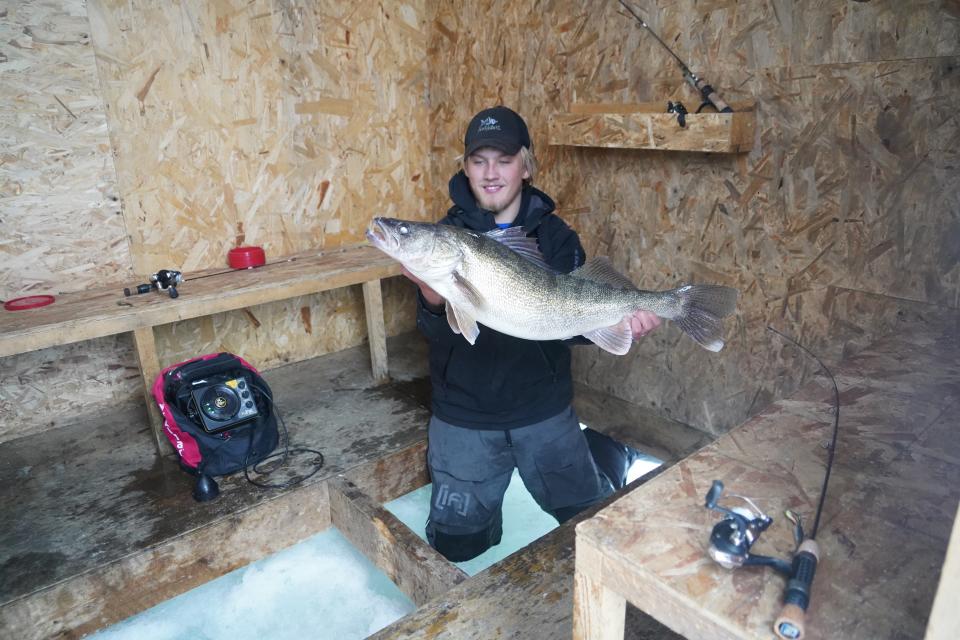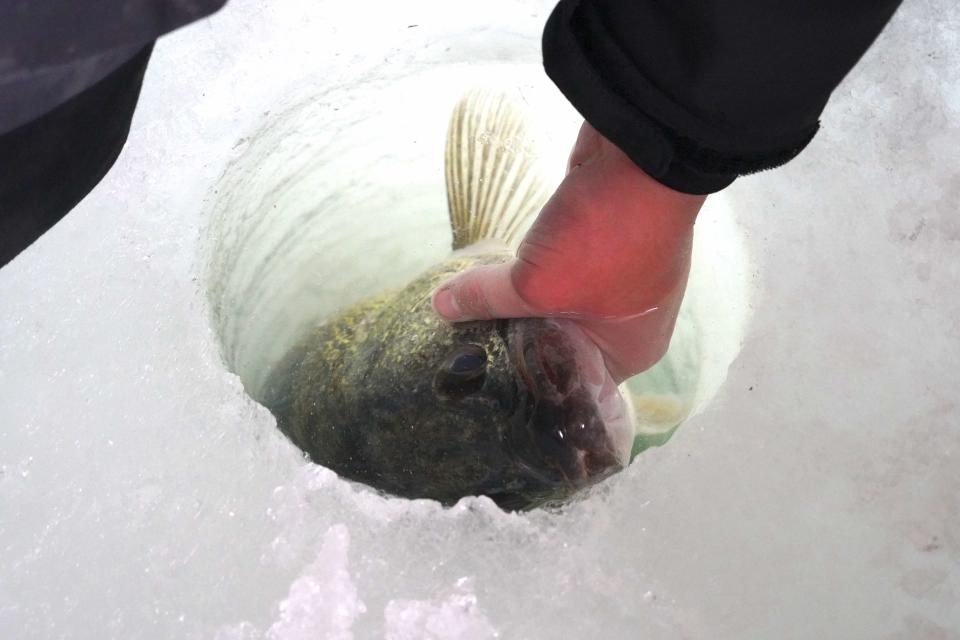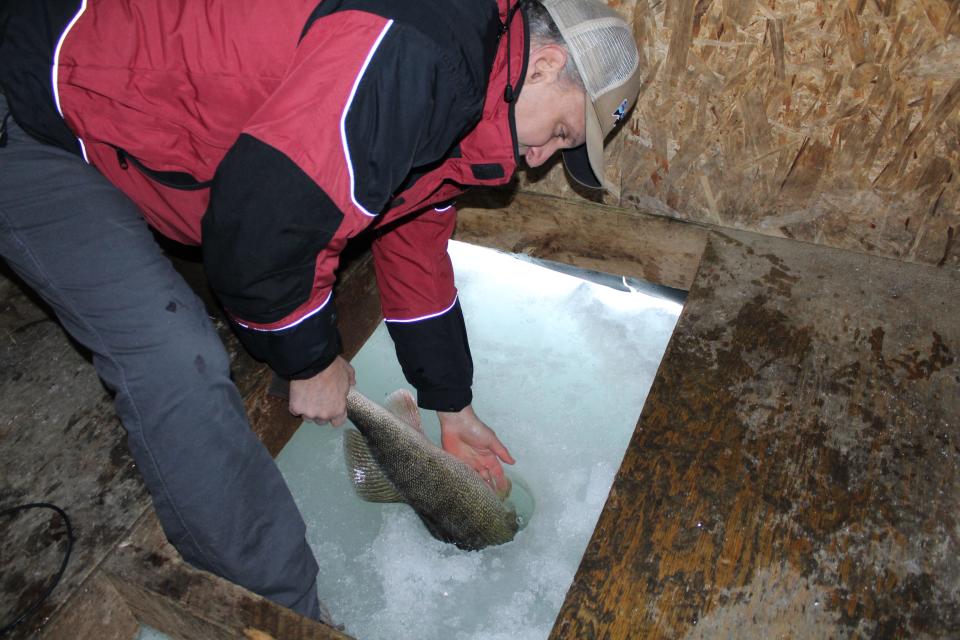Smith: After a kick start, Green Bay has grown naturally into one of the nation's star walleye fisheries

STURGEON BAY - The waters of Rileys Bay had already been good to us last Thursday morning.
By 9 a.m. not only had our group landed several lake whitefish, the target species for the outing, but the sheltered nook on the eastern shore of Green Bay held 15 inches of solid ice, an anomaly on the Great Lakes this winter.
The hard surface allowed us to use UTV's to safely get to fishing shacks set about 1 mile out on Rileys Bay by Alexander's Sport Fishing and Ice Fish Green Bay.
Open water was visible to the northwest.
But at least for the day we were secure in this protected corner of Green Bay, the 1,600-square-mile lobe of Lake Michigan that spans from northeastern Wisconsin to the Upper Peninsula of Michigan.
Fishing guide Brody Alexander, 19, of Green Bay joined me in one shack, while his colleague Eli Hank of Sturgeon Bay and 12 other anglers from Michigan and Wisconsin were scattered in nearby shanties and on the open ice.
Green Bay an outstanding multi-species fishery
As you likely know, over the last 15 years an outstanding ice fishery for whitefish has developed on Green Bay. The tasty native fish, once thought of only as part of the commercial harvest, has emerged as a valued sport fish.
Brody's father, Bret Alexander, helped refine tactics and pioneer the sport fishery for whitefish. It now draws thousands of anglers each winter to Brown and Door counties.
But it's only one part of Green Bay's tremendous multi-species fishery, which also features muskellunge, smallmouth bass, northern pike, yellow perch and, what many consider the marquee fish, walleye.
Brody and I fished in holes on opposite sides of the shanty and talked about the opportunities and challenges of fishing in the bay, season by season, especially during a time of poor ice. The water was 27 feet deep; we used a "trio rig" with a jig tipped with a soft plastic tail on the bottom and two single hooks each baited with a wax worm spaced one and two feet above.
Each of us used a flasher, an electronic unit that allows anglers to see their baits and fish in the water below.
At 9:30 a large mark appeared on my flasher that helped put the fishery in perspective.
'Big walleye. Really big.'
I felt a nudge on the line and lifted hard in an attempted hook-set. Nothing. As I let the baits settle back toward bottom the flasher again lit up, signaling a fish. This time as I jigged the line went taut. A second swing connected.
With all due respect to whitefish, from the first seconds it was clear this fish was a "horse of a different color."
It stayed toward the bottom for at least a minute, straining the 4-foot-long graphite spinning rod. When it came up a few feet it then descended, taking out drag.
This was one of those rare angling occasions when it was clear - the fish was in control.
Brody hopped over and pulled the transducer out of the hole to make landing the fish easier. He also peered down the hole to try to get a glimpse at the fish.
We speculated on what it might be, rattling off the many great sport fish in these waters, including burbot. After another couple minutes, it was 5 feet below the hole.
It turned and showed its broad, brown flank and white-tipped tail.
"Yep, big walleye," Brody said. "Really big."
A minute later I was able to turn its head up the hole and Brody expertly reached down and, without touching its gills, lifted it above the ice.

It was a large female, its abdomen bulging with eggs; it fit through the 8-inch-diameter hole, but with very little room to spare.
Brody quickly removed the jig then held the fish in the water so it could breath while Eli and I gathered a digital scale and a measuring stick.
The catch had stolen the spotlight from the whitefish and put it on what many consider the shining star of the fishery.
Green Bay's walleye population recovers after suffering from pollution and overexploitation
Over the last 25 years or so, the bay's walleye populations have increased and earned the area a reputation as one of the nation's top walleye fisheries.
It wasn't always so. In fact walleye stocks in southern Green Bay were decimated during the early to mid-1900s by habitat destruction, pollution, invasive species and over-exploitation.
Following water quality improvements in the early 1970s, the Wisconsin Department of Natural Resources began to stock fry and fingerling fish to rehabilitate the walleye population. The stocking provided a kick-start for natural reproduction in the bay.
It was so successful that stocking was discontinued in Green Bay and the Fox River in 1984 and in the Sturgeon Bay area in 2012.
Four decades ago, if I wanted a world-class walleye fishing experience in the Midwest my go-to destination was the western basin of Lake Erie. But that required about seven hours of driving each way and usually ate up a long weekend.
Now I and legions of other Wisconsin-based anglers opt to go to Green Bay; the waters feature very good numbers of walleyes and the chance to catch trophies, too.
Green Bay's total catch of walleyes during the 2021 open water season was highest on record
And the cherry on top is all fish are naturally reproduced.
To gauge the bay's walleye population, the DNR conducts several annual assessments.
It starts with a spring electrofishing survey on the Lower Fox River to collect information on the age and size structure of adult fish gathered to spawn near the De Pere dam.
Then in fall the agency conducts electrofishing surveys in a broader area, including the Fox River and lower Green Bay, to assess year class strength of adult and young-of-the-year walleyes.
And to gain an understanding of catch and harvest rates, it conducts creel surveys of ice and open water anglers for much of the year.
The total catch of walleyes during the 2021 open water season on Green Bay was estimated at 318,101 fish, highest on record since creel surveys started in 1986 and 43% higher than the estimated average annual total catch from 2013-19.
Of those walleyes caught in 2021, anglers kept 153,054 fish, also a record since 1986 and 61% higher than the 2013-19 average. The DNR attributed the increases in catch and harvest of walleyes over the last 20 years to increases in the adult walleye population and consistent recruitment.
"This is a great fishery, especially when you consider we're not stocking fish and the natural reproduction continues to support it," said Dave Boyarski, DNR fisheries supervisor in Sturgeon Bay.
Boyarski said the bay now features the two strongest year classes (2013 and 2018) documented in fall electrofishing surveys since 1993. The 2018 fish are now making up much of the catch.

The future for walleye in Green Bay
The additional harvest and pressure on the fishery in recent years has caused concern among some anglers about the long-term sustainability of the bay's walleye population and led to calls for more restrictive regulations, including a reduced daily bag limit.
That's understandable. True conservationists want to protect resources.
In this case, it's not clear if more protection is needed, Boyarski said.
But the DNR is proposing a study to help inform future management decisions. Similar to work done on the Winnebago System, it would involve a walleye tagging and reward system to better understand exploitation rates on adult fish.
Smith:Sturgeon spearing season on tap for Winnebago System
Walleyes For Tomorrow, the Wisconsin-based conservation organization, is considering offering its help to fund the proposed 5-year study.
I support the proposal and hope it gets implemented in the near future.
The bay's outstanding walleye fishery deserves the best, science-based management available.
In the meantime anglers can assist by practicing selective harvest.
After we assembled the equipment, the big walleye on Rileys Bay measured 30.5 inches and weighed 11.65 pounds. We snapped a few photos and got her back in the water. After 15 seconds to adjust, she wagged her tail strongly and swam out of sight.
Here's hoping she is able to lay those eggs and many survive, augmenting another year class of walleyes on Green Bay, a star fishery and symbol of what's possible when we clean up the environment and use smart science-based management to give native species a chance to recover.
Our subscribers make this reporting possible. Please consider supporting local journalism by subscribing to the Journal Sentinel at jsonline.com/deal.
DOWNLOAD THE APP: Get the latest news, sports and more
This article originally appeared on Milwaukee Journal Sentinel: Green Bay grows naturally into one of nation's star walleye fisheries
